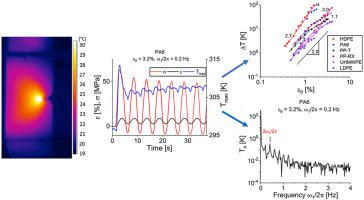Polymer Testing ( IF 5.1 ) Pub Date : 2021-01-13 , DOI: 10.1016/j.polymertesting.2021.107070 Valerian Hirschberg , Manfred Wilhelm , Denis Rodrigue

|
This work investigates the phenomena of self-heating, also called intrinsic heating, and thermoelastic coupling during non-linear dynamic mechanical fatigue testing via surface temperature measurement coupled with the mechanical behavior of polymers. Static tensile tests and dynamic strain controlled fatigue tests under tension/tension were performed at a frequency of ω1/2π = 5 Hz, as well as in the low cycle fatigue regime at ω1/2π = 0.2 Hz, on six polymers: high density polyethylene (HDPE), low density polyethylene (LDPE), ultra high molecular weight polyethylene (UHMWPE), polyamide 6 (PA6), and two grades of polypropylene (PP).
In dynamic testing, the surface temperature rises to a plateau value (ΔT) when an equilibrium between the viscous/plastic dissipated energy and heat convection is reached. Power-law correlations were found between the strain amplitude (ε0) and ΔT, as well as between ε0 and the calculated dissipated energy density (Wdiss,p) obtained from the mechanical stress response, with similar exponents for both correlations. Thermoelastic coupling is firstly investigated in uniaxial tension, revealing a linear relation between the strain rate and the rate of temperature decrease, which is more distinct with decreasing polymer chain mobility. In dynamic fatigue testing, the surface temperature was found to oscillate with an amplitude T1, which was analyzed via Fourier transform. A direct relation between T1 and ε0 at small deformations was observed. At large strain amplitudes, T1 (ε0) follows a similar trend as the complex modulus E*(ε0). At low frequencies and large strain amplitudes, additional higher harmonics at two (T2) and three (T3) times the fundamental frequency were also detected as fingerprints of plastic deformation, resulting in additional heat dissipated during the loading half cycle. From the results obtained, the advantages of the calculated dissipated energy density over the surface temperature analysis was analyzed to predict the fatigue behavior. This analysis is believed to be valid for all materials due to the mathematical/physical principles involved. The results are thus expected to hold for other materials such as composites, rubbers, ceramics and metals.
中文翻译:

结合机械表面和热表面傅立叶变换分析来跟踪聚合物的动态疲劳行为
这项工作研究了非线性动态机械疲劳测试过程中通过表面温度测量与聚合物的机械性能耦合而产生的自热现象(也称为固有加热)和热弹性耦合。静态拉伸试验和下张力/张力动态应变控制疲劳试验在频率进行ω 1 /2π = 5赫兹处,以及在低循环疲劳机制ω 1 /2π = 0.2赫兹,在六个聚合物:高高密度聚乙烯(HDPE),低密度聚乙烯(LDPE),超高分子量聚乙烯(UHMWPE),聚酰胺6(PA6)和两种等级的聚丙烯(PP)。
在动态测试中,当达到粘性/塑性耗散能量与热对流之间的平衡时,表面温度上升至平稳值(ΔT)。应变振幅之间发现幂律相关(ε 0)和ΔT,以及之间ε 0和所计算的耗散能密度(w ^ DISS,对)是从机械应力响应获得的,两个相关系数相似。首先在单轴张力下研究热弹性偶合,揭示了应变速率和温度降低速率之间的线性关系,随着聚合物链迁移率的降低,这种关系更加明显。在动态疲劳测试中,发现表面温度以幅度T 1振荡,并通过傅立叶变换对其进行了分析。之间的直接关系Ť 1和ε 0,观察到在小的变形。在大应变振幅,Ť 1(ε 0)遵循类似的趋势作为复数模量E *(ε 0)。在低频和大应变振幅下,在基频的两倍(T 2)和三倍(T 3)处还检测到了额外的高次谐波,作为塑性变形的指纹,从而导致在加载半周期内耗散了额外的热量。根据获得的结果,分析了计算的耗散能量密度相对于表面温度分析的优势,以预测疲劳行为。由于所涉及的数学/物理原理,该分析被认为对所有材料均有效。因此,预期结果对于其他材料如复合材料,橡胶,陶瓷和金属将保持不变。


























 京公网安备 11010802027423号
京公网安备 11010802027423号